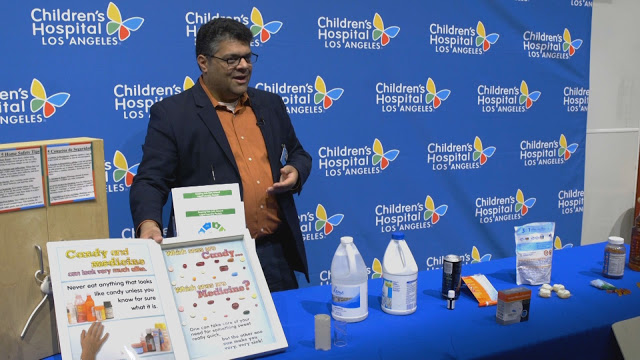

| Online: | |
| Visits: | |
| Stories: |

| Story Views | |
| Now: | |
| Last Hour: | |
| Last 24 Hours: | |
| Total: | |
Five Ways to Protect Your Child from Household Poisons
As part of National Poison Prevention Week, March 19-25, Children’s Hospital Los Angeles (CHLA) pediatric medical toxicologist Cyrus Rangan, M.D., assistant medical director of the California Poison Control System, is stressing poison prevention in homes, where 80 percent of poison control calls originate. Dr. Rangan says CHLA alone treated almost 100 cases of poison exposure in 2016, mostly related to kids ingesting household items or unsecured medications. Different poisons can trigger numerous severe reactions, from trouble breathing to accelerated heart rate to blocked intestines and even affected mental states.
Dr. Rangan tells parents and guardians to keep these tips in mind:
More than 60,000 U.S. children end up in emergency rooms each year after swallowing medication left within reach. Dr. Rangan says kids will break into tamper-resistant bottles given enough time, so parents should keep meds high and locked away “out of sight, out of reach, out of mind.” He also recommends not transferring pills to other containers, such as flip-top canisters labeled with days of the week. This makes it harder to identify what a child accidentally swallowed and how to treat it.
Like sweets, pills and vitamins are colorful and sometimes sugarcoated (or even in “gummy” form). Dr. Rangan says it’s risky and confusing to trick kids into taking their medicine by pretending it’s candy. “Medicine is medicine, candy is candy,” he says. “Make sure we keep them separate not only in our homes but also in our minds.”
Credit: Children’s Hospital Los Angeles (CHLA)
In the last few years, products like laundry/dishwasher detergent pods; e-cigarettes (and their cartridges); and energy drinks have all become popular. All contain highly concentrated chemicals – detergent, nicotine, caffeine – and are often scented or flavored. These are especially dangerous for younger kids. “We’ve seen very, very young children who swallow some of these and end up in the intensive care unit, have a change in their mental status and wind up on respirators,” says Dr. Rangan.
“You may have a bottle that has a brownish liquid in it,” says Dr. Rangan. “If it’s in your refrigerator, it’s very likely to be apple juice. But if it’s in your garage, it’s likely to be a cleaner. Because they look the same and are sometimes in bottles that are very, very similar, a young child tends not be able to tell the difference.”
Despite your best efforts, a child may still come in contact with a toxic substance. Dr. Rangan says to call 911 if the child stops breathing or responding. Otherwise, the national 24-hour Poison Control Hotline, 1-800-222-1222, will connect you to certified specialists at your regional poison control center. Many are nurses and pharmacists, backed up by medical toxicologists like Dr. Rangan, who can help you determine whether to stay home or go to the ER.
The good news is doctors say treatments have come a long way in a few decades for patients who are poisoned. While that has led to an overall drop in poison-related deaths, accidental overdoses in children are still rising. That’s why experts continue to underscore prevention and supervision as the best line of defense.
“We don’t like treating children with poisonings. We like preventing them from getting them in the first place,” Dr. Rangan says. “And as we get into spring and summer months, and children are spending more time at home… despite how much supervision we give them, children still are very capable at finding substances and possibly causing a poisoning emergency.”
Owen Lei
Source: http://www.ineffableisland.com/2017/03/five-ways-to-protect-your-child-from.html



